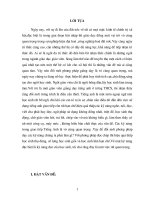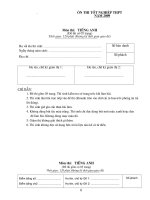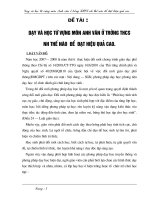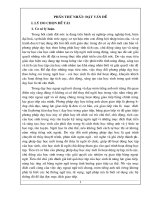SKKN môn Tiếng Anh (THPT)
Bạn đang xem bản rút gọn của tài liệu. Xem và tải ngay bản đầy đủ của tài liệu tại đây (77.01 KB, 14 trang )
Preface
I) Reasons for this study:
When a person hear the term evaluation, the first thought that often
comes to mind is tests or grades. Can you remember how you felt as a
young child waiting for the teacher to return a test paper from a difficult
examination? What about the sleepless nights before an important
examination in school or the wait for the postcard reporting a final grade?
Although the teacher gives many tests to measure how well the student
has attained the objectives and to assign his final grade, evaluation plays a
role in many other teacher’s dicisions. Before beginning instruction, teachers
often need to assess the students backgrounds or entry behavior to set the
appropriate level for instruction. During instruction it is sometimes
necessary to diagnose students’strength and weakness to discover why they
may be having difficulty in a particular subject. The teacher may have to
assess students attitudes about classroom procedures and perhaps change his
behavior to accommodate them. These are just a few of the reasons for
obtaining evaluation information. For teacher to evaluate properly they must
know what kind of judgements and decisions are called for and how to gather
information for their decisions.
II) Scope of the study:
From that point of view, I would like to present this paper which
covers only a small area of study, and focusses on two questions “what are
teacher-made tests?” and “how can the theory be applied to English tests?”.
some kinds of teacher - made tests 1
III. Methods of the study:
Three main methods have been applied, that is, synthesis, analysis and
illustration.
IV. References:
Making a good test has been a big challenge to any instructors and
they have made great contribution and studies in this area. Therefore I do not
want to create any thing new but sum up and learn from others’ experience:
- Short- cut statistics for teacher-made tests by Deiderich.P.B.
- Teaching for learnining by D.Feness
- And other reference books.
some kinds of teacher - made tests 2
Contents
I) Kinds of teacher- made tests.
II) Planning the tests
III) Writing test items
1. Multiple-choice items.
2. Completion items.
3. True- false items.
4. Essay questions.
some kinds of teacher - made tests 3
I. Kinds of teacher-made tests:
According to D.Feness, there are two kinds of tests, that is, teacher-
made and standardized ones. Standardized tests are useful for determining
how local achievement compares to national norms. The teacher- made tests
are more useful for measuring individual classroom instruction.
Teacher –made achievement tests are usually divided into two
catergories: (1) the objective tests, which are highly structured and limit the
type of response a student can make. The answer key desinates a response as
correct or incorrect. These tests include multiple-choice, completion,
matching, and true-false items; (2) the subjective or essay tests, which
allow a student to impose his own organization on the material and present it
on his own words. In scoring an essay test, the teacher must make qualitative
decisions about how close a student’s answer is to modal answer.
There are no rules for using using an objective or subjective test other
than the consideration of what the teacher want to measure and the available
time for the task. Many teachers use combinations of both types of tests,
since each has its own merits and limitations. A comparision of essay and
objective tests appear in the table below:
A comparision of essay and objective test:
Essay Objective.
Requires the student to express
himself in his own words, using
information from his own back
ground and knowledge.
Requires the student to
select correct answer from given
option, or to supply an anwer
limited to one word or phrase.
some kinds of teacher - made tests 4
Can tap high level of reasoning
such as requred in inference
organization of ideas, comparision
and contrast.
Can also tap high level of
reasoning such as reqired in
inference, organization of idea,
comparision and constrast.
Does not measure purely
factual information effectively.
Measures knowledge of fact
efficiently.
Covers only a limited field of
knowledge in any one test. Essay
questions take so long to answer that
relatively few can be answer in a
given period of time. Also, the
student who is esspecially fluent can
often avoid disscussing poin of which
his is unsure.
Covers a broad field of
knowledge in one test. Since
objective questions may be answer
quickly, one test may contain many
questions.A abroad coverage help
provide reliable mesurement.
Encorages students to learn
how to organize their own ideal and
express them effectively.
Encorages students to build
up a broad background of
knowledge and ability.
Requires only a few questions
for the test. Task must be clearly
defined, genaral enough to offer
some leeway, specific enough to set
limits.
Requires writing many
questions for a test.Wording must
avoid ambiguities and “
giveaway”.Distractors should
embody most likely
misconceptions.
Usually very time-consuming
to score.
Can be scored quickly.
Permits teachers to comment
directly on the reasoning process of
Answers generally scored
only right or wrong, but scoring is
very accurate and consitent.
some kinds of teacher - made tests 5









